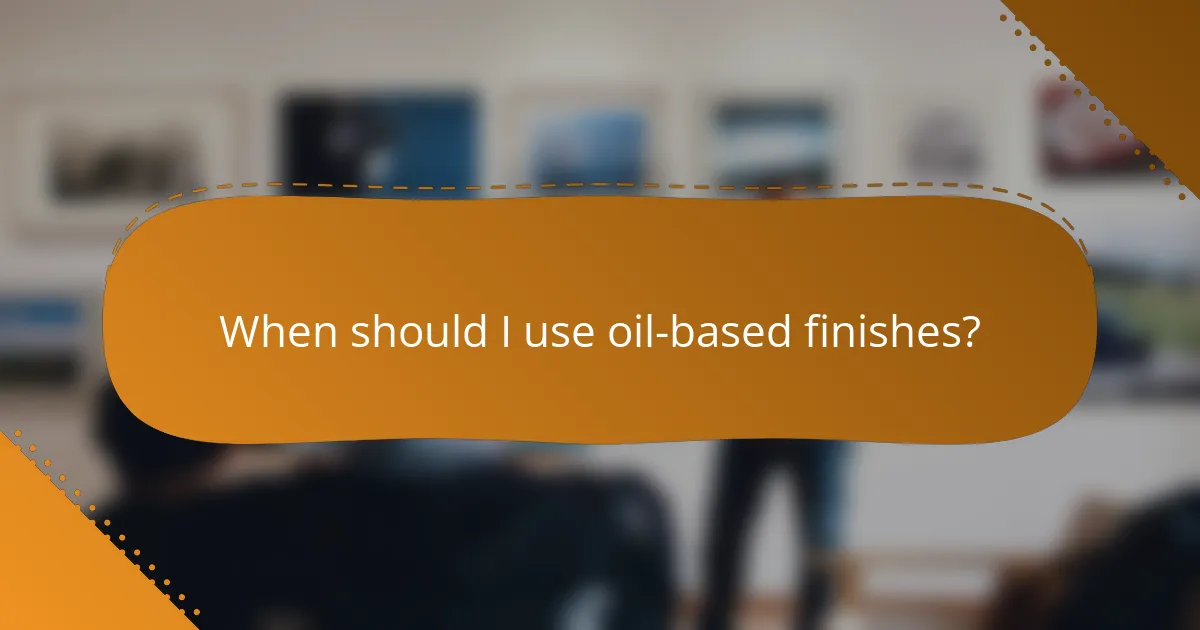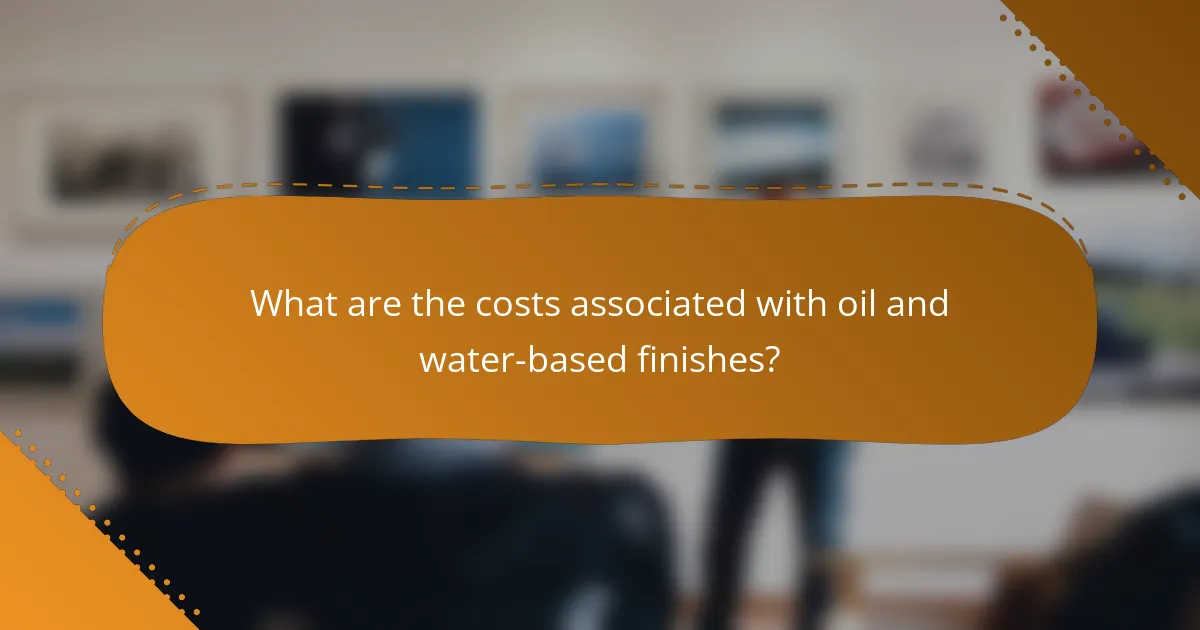Choosing between oil-based and water-based finishes is crucial for achieving the desired results in your woodworking projects. Oil-based finishes excel in durability and enhancing wood’s natural beauty, while water-based options offer quick drying times and lower environmental impact. Understanding the strengths of each type will help you select the best finish for your specific needs.

Which finish is better for woodworking projects?
The choice between oil-based and water-based finishes depends on the specific needs of your woodworking project. Each type offers distinct advantages that cater to different applications, preferences, and environmental considerations.
Oil-based finishes provide durability
Oil-based finishes are known for their exceptional durability, making them ideal for high-traffic surfaces like furniture and cabinetry. They form a tough film that resists scratches, heat, and moisture, which can be crucial in kitchens or bathrooms.
When applying oil-based finishes, expect a longer curing time, often taking several days to fully harden. This extended drying period allows for a more robust finish but requires patience during the project timeline.
Water-based finishes offer easy cleanup
Water-based finishes are favored for their ease of cleanup, as they can be washed away with soap and water before drying. This makes them a convenient choice for DIY enthusiasts and professionals alike, especially in home workshops.
Additionally, water-based finishes emit fewer volatile organic compounds (VOCs), making them a healthier option for indoor use. This lower toxicity is beneficial for both the environment and the user, particularly in enclosed spaces.
Oil-based finishes enhance grain depth
One of the standout features of oil-based finishes is their ability to enhance the natural grain of wood. They penetrate deeply, bringing out rich colors and textures that can elevate the aesthetic appeal of the project.
This depth of color can be particularly striking on hardwoods, where the finish can highlight unique patterns and variations. If visual impact is a priority, oil-based finishes are often the preferred choice.
Water-based finishes dry quickly
Water-based finishes dry significantly faster than their oil-based counterparts, often within one to two hours. This quick drying time allows for multiple coats to be applied in a single day, speeding up the overall finishing process.
However, this rapid drying can also lead to challenges, such as a shorter working time before the finish sets. It’s essential to work efficiently and apply the finish in manageable sections to avoid issues with streaking or uneven application.

When should I use oil-based finishes?
Oil-based finishes are best used when durability and a rich appearance are priorities. They provide a hard, protective layer that enhances the natural beauty of wood, making them suitable for various applications.
Use for high-traffic furniture
Oil-based finishes are ideal for high-traffic furniture such as dining tables and chairs. Their robust nature resists scratches and wear, ensuring longevity even with frequent use.
When applying oil-based finishes to high-traffic items, consider using a product with a higher solid content for added durability. Regular maintenance, like reapplying every few years, can help maintain the finish’s integrity.
Ideal for outdoor applications
For outdoor furniture and structures, oil-based finishes offer excellent protection against moisture and UV damage. They penetrate deeply into the wood, providing a barrier that helps prevent warping and cracking.
Choose a marine-grade oil-based finish for the best results in outdoor settings. Regularly inspect and reapply the finish annually to ensure continued protection against the elements.

When should I use water-based finishes?
Water-based finishes are ideal when you need a quick-drying solution that minimizes odor and environmental impact. They are best suited for indoor applications where a clear, durable finish is desired without the strong fumes associated with oil-based products.
Best for indoor furniture
Water-based finishes are particularly effective for indoor furniture because they dry quickly and emit fewer volatile organic compounds (VOCs). This makes them safer for home environments, especially in spaces where children or pets are present. They provide a clear finish that enhances the natural beauty of wood without yellowing over time.
When applying water-based finishes to indoor furniture, ensure proper ventilation to facilitate drying and reduce any lingering odors. A light sanding between coats can improve adhesion and result in a smoother final appearance.
Suitable for quick projects
If you’re working on a project with a tight timeline, water-based finishes are your best bet. They typically dry to the touch within an hour, allowing for multiple coats to be applied in a single day. This rapid drying time makes them ideal for DIY projects or repairs that need to be completed swiftly.
When using water-based finishes for quick projects, consider using a foam brush or a spray applicator for an even coat. Be mindful of humidity levels, as high moisture can extend drying times and affect the finish quality.

What are the key differences between oil and water-based finishes?
Oil and water-based finishes differ primarily in their composition, drying times, and application methods. Oil finishes typically provide a richer color and depth, while water-based finishes are known for their quick drying and lower odor.
Drying time varies significantly
Oil-based finishes generally take much longer to dry, often requiring several hours to a day before recoating. In contrast, water-based finishes can dry in as little as 30 minutes to a few hours, allowing for quicker project completion.
This difference in drying time can impact workflow; if you need to apply multiple coats in a single day, water-based finishes are often the better choice. However, the longer drying time of oil finishes can allow for more thorough penetration into the wood, enhancing durability.
Application methods differ
When applying oil-based finishes, brushes or rags are commonly used, as they allow for even distribution and better absorption. Water-based finishes can be applied with brushes, rollers, or sprayers, providing versatility in application techniques.
It’s essential to consider the tools you’ll use; oil finishes may require more cleanup due to their solvent-based nature, while water-based products typically clean up easily with soap and water. Always follow the manufacturer’s recommendations for the best results.
Environmental impact considerations
Water-based finishes are generally more environmentally friendly, emitting fewer volatile organic compounds (VOCs) compared to oil-based options. This makes them a preferable choice for indoor applications where air quality is a concern.
In some regions, regulations may restrict the use of high-VOC products, making water-based finishes not only a safer choice but also a compliant one. Always check local guidelines to ensure you are using finishes that meet environmental standards.

How do I choose the right finish for my project?
Choosing the right finish for your project involves understanding the type of wood, the intended use, and the desired appearance. Each finish type—oil-based or water-based—offers distinct advantages and drawbacks that can affect your final result.
Consider the type of wood
The type of wood you are working with plays a crucial role in selecting a finish. Hardwoods like oak or maple often benefit from oil-based finishes, which penetrate deeply and enhance the natural grain. In contrast, softer woods such as pine may be better suited for water-based finishes, which dry quickly and provide a clear coat without yellowing over time.
Additionally, consider the wood’s porosity. Highly porous woods may require multiple coats of oil-based finishes to achieve even coverage, while water-based options can be applied in thinner layers for a smoother finish.
Evaluate the intended use
Your project’s intended use significantly influences the choice of finish. For high-traffic areas or surfaces that will face moisture, oil-based finishes offer superior durability and resistance to wear. However, for furniture or cabinetry that requires quick drying times and easy cleanup, water-based finishes are often preferable.
Think about the environment as well. If the project will be exposed to harsh conditions, such as outdoor furniture, oil-based finishes typically provide better protection against UV rays and weathering.
Assess the desired appearance
The desired appearance of your finished project can guide your choice between oil and water-based finishes. Oil-based finishes tend to impart a warm, rich tone that enhances the wood’s natural beauty, making them ideal for projects where aesthetics are paramount.
On the other hand, water-based finishes offer a clearer, more natural look, which is beneficial if you want to maintain the original color of the wood. They also dry clear and are less likely to yellow over time, making them suitable for lighter woods or projects where color fidelity is essential.

What are the costs associated with oil and water-based finishes?
The costs of oil and water-based finishes vary significantly, impacting your budget for projects. Generally, oil-based finishes tend to be more expensive than their water-based counterparts, but the choice may depend on the specific application and desired results.
Oil-based finishes often cost more
Oil-based finishes typically range from moderate to high prices, often due to the quality of materials used and their durability. For instance, a gallon of oil-based polyurethane can cost between $30 and $60, depending on the brand and formulation.
When considering oil-based finishes, factor in not only the initial cost but also the longevity and maintenance requirements. These finishes may require fewer applications over time, potentially offsetting their higher upfront price.
Water-based finishes are generally cheaper
Water-based finishes are usually more budget-friendly, often priced between $20 and $40 per gallon. Their lower cost makes them an attractive option for DIY projects or larger applications where budget constraints are a concern.
While cheaper, water-based finishes may require more frequent reapplication and can be less durable than oil-based options. However, they dry faster and have lower levels of volatile organic compounds (VOCs), making them safer for indoor use.

What are the maintenance requirements for each finish?
Oil-based and water-based finishes have distinct maintenance needs that affect their longevity and appearance. Understanding these requirements helps in choosing the right finish for your project.
Oil-based finishes require periodic reapplication
Oil-based finishes typically need reapplication every few years, depending on the wear and tear of the surface. High-traffic areas may require more frequent maintenance, while less-used surfaces can last longer before needing attention.
To maintain an oil-based finish, clean the surface regularly and inspect for signs of wear. When reapplying, ensure the surface is clean and lightly sanded to promote adhesion of the new coat.
Common pitfalls include neglecting to clean the surface before reapplication and applying a new coat too soon, which can lead to uneven finishes. A good rule of thumb is to check the finish annually and plan for reapplication every 2-5 years based on usage.
Water-based finishes require less frequent maintenance
Water-based finishes generally require less frequent reapplication compared to oil-based options, often lasting 3-7 years before needing maintenance. They dry quickly, allowing for faster project completion and less downtime.
For maintenance, simply clean the surface with a mild detergent and water. If the finish begins to dull or shows signs of wear, a light sanding followed by a fresh coat can restore its appearance.
One advantage of water-based finishes is their lower odor and quicker drying time, making them ideal for indoor projects. However, they may not be as durable in high-traffic areas compared to oil-based finishes, so consider the specific application when choosing.


